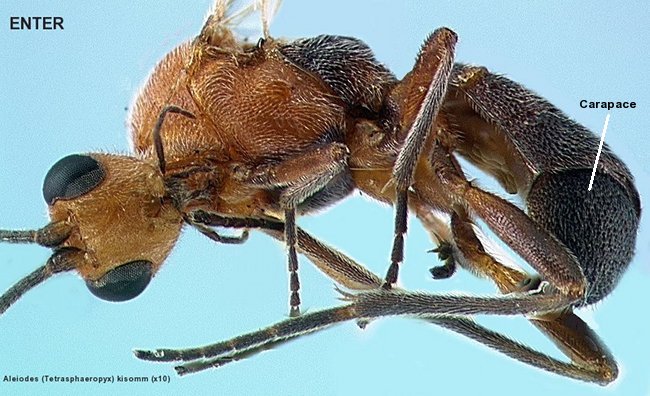Welcome to Aleiodes (Tetrasphaeropyx) of the world, an interactive identification tool providing a fully illustrated means of identification for all currently described species of Tetrasphaeropyx Ashmead, a subgenus of Aleiodes Wesmael. Aleiodes (Tetrasphaeropyx) is a group of parasitic wasps that exclusively attack inchworm caterpillars so far as known. This key is drawn from a larger study that culminated in a published monograph (Fortier 2009). In addition to the Lucid identification tool, Tetrasphaeropyx of the World provides illustrated background
Aleiodes (Tetrasphaeropyx) species belong to the large cosmopolitan parasitoid wasp family Braconidae. Keys to Braconidae may be found in Goulet and Huber 1993, Hanson and Gauld 1995, and Wharton et al. 1997.
Tetrasphaeropyx was at one time considered to be a distinct genus (Ashmead 1888). It was later found to be at the apex of the coxalis species-group within Aleiodes (Fortier and Shaw 1999), and presently (Fortier 2009) has been found to constitute a monophyletic group within Aleiodes. Tetrasphaeropyx can be separated from other Aleiodes species by the metasomal tergite IV enlarged to form a carapace (see image), which entirely or nearly entirely covers all metasomal segments posterior to it. Tetrasphaeropyx species are rarely collected, and may be rare in nature. However, 35% of all described species are represented by specimens that have been reared from host material - in all cases, from inchworms (Geometridae). Tetrasphaeropyx species are generally distributed as follows: eight species in western Canada and Alaska, nine species in eastern Canada, seven species in western US, 27 species in the southwestern US including Texas and California, seven species in the north-central US, six species in northeastern US, four species in southeastern US, and six species in Mexico. New exploration is almost certain to turn up many more species in Mexico, especially in the arid north. Ashmead, W. H. 1888. Descriptions of new Braconidae in the collections of the U. S. National Museum. Proceedings of the U. S. National Museum 11: 611-671.
 information pertinent to taxonomic study of Tetrasphaeropyx such as basic biological information, morphology, and a glossary of terminology. This key is intended to be useful for specialists and non-specialists. The monograph provides additional details such as descriptive and distributional information, type material location, and validation of new names following ICZN rules. A traditional dichotomous key is in the monograph for those preferring that method of identification, and as a backup check to the Lucid key. The Lucid key provides a more user friendly format than a dichotomous key for specimen identification. This key may not always provide a correct answer, as if the specimen being keyed belongs to a new species not described in the Zootaxa monograph.
information pertinent to taxonomic study of Tetrasphaeropyx such as basic biological information, morphology, and a glossary of terminology. This key is intended to be useful for specialists and non-specialists. The monograph provides additional details such as descriptive and distributional information, type material location, and validation of new names following ICZN rules. A traditional dichotomous key is in the monograph for those preferring that method of identification, and as a backup check to the Lucid key. The Lucid key provides a more user friendly format than a dichotomous key for specimen identification. This key may not always provide a correct answer, as if the specimen being keyed belongs to a new species not described in the Zootaxa monograph.
Fortier, J. C. and S. R. Shaw. 1999. Cladistics of the Aleiodes Lineage of the subfamily Rogadinae (Hymenoptera: Braconidae). Journal of Hymenoptera Research 8:2: 204-237.
Fortier, J. C. 2009. A Revision of the Tetrasphaeropyx Lineage of the Genus Aleiodes Wesmael (Hymenoptera: Braconidae: Rogadinae). Zootaxa 2256: 1-126.
Goulet, H. and J. T. Huber. 1993. Hymenoptera of the world: an identification guide to families. Agriculture Canada Publication (Ottawa) 1894-E:i-vii, 668 pp.
Hanson, P. E. and I. D. Gauld. 1995. The Hymenoptera of Costa Rica. Oxford University Press (Oxford). 893 pp.
Wharton, R. A., P. M. Marsh, and M. J. Sharkey. 1997. Manual of the New World Genera of the Family Braconidae (Hymenoptera). Special Publication of the International Society of Hymenopterists, Number 1 (Washington D.C.) 439 pp.